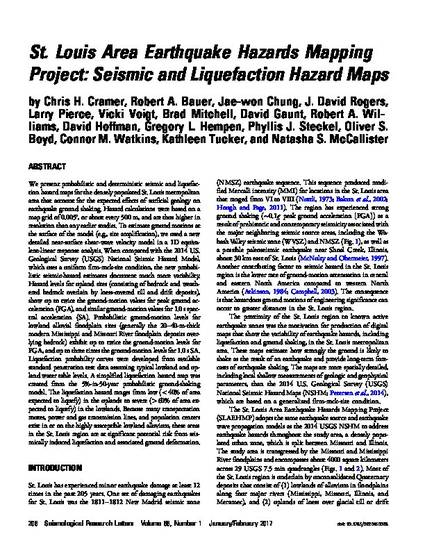
We present probabilistic and deterministic seismic and liquefaction hazard maps for the densely populated St. Louis metropolitan area that account for the expected effects of surficial geology on earthquake ground shaking. Hazard calculations were based on a map grid of 0.005°, or about every 500 m, and are thus higher in resolution than any earlier studies. To estimate ground motions at the surface of the model (e.g., site amplification), we used a new detailed near-surface shear-wave velocity model in a 1D equivalent- linear response analysis. When compared with the 2014 U.S. Geological Survey (USGS) National Seismic Hazard Model, which uses a uniform firm-rock-site condition, the new probabilistic seismic-hazard estimates document much more variability. Hazard levels for upland sites (consisting of bedrock and weathered bedrock overlain by loess-covered till and drift deposits), show up to twice the ground-motion values for peak ground acceleration (PGA), and similar ground-motion values for 1.0 s spectral acceleration (SA). Probabilistic ground-motion levels for lowland alluvial floodplain sites (generally the 20-40-m-thick modern Mississippi and Missouri River floodplain deposits overlying bedrock) exhibit up to twice the ground-motion levels for PGA, and up to three times the ground-motion levels for 1.0 s SA. Liquefaction probability curves were developed from available standard penetration test data assuming typical lowland and upland water table levels. A simplified liquefaction hazard map was created from the 5%-in-50-year probabilistic ground-shaking model. The liquefaction hazard ranges from low (<40% of area expected to liquefy) in the uplands to severe (>60% of area expected to liquefy) in the lowlands. Because many transportation routes, power and gas transmission lines, and population centers exist in or on the highly susceptible lowland alluvium, these areas in the St. Louis region are at significant potential risk from seismically induced liquefaction and associated ground deformation.
- Banks (Bodies Of Water),
- Deposits,
- Earthquake Effects,
- Floods,
- Geology,
- Geophysics,
- Groundwater,
- Hazards,
- Induced Seismicity,
- Landforms,
- Liquefaction,
- Seismic Response,
- Seismology,
- Shear Flow,
- Shear Waves,
- Transportation Routes,
- Urban Planning,
- Wave Propagation,
- Saint Louis County [Missouri],
- United States
Available at: http://works.bepress.com/j-rogers/55/
